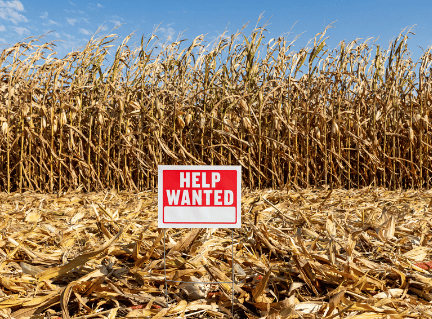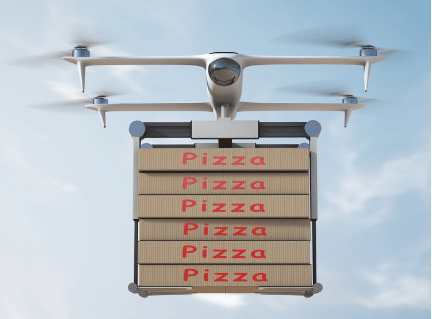The Dark Side of the Labor Shortage Nobody Wants to Talk About

Table of contents
- 1) We’re in a Post-Pandemic Mental Health and Addiction Crisis
- 2) Declines in Immigration Trends Could Cripple Our Food Supply System
- 3) Some Companies Are Automating Service Industry Jobs Altogether
- 4) Long-COVID Could Be Preventing People from Returning to Work
- Frontline Success Is Now Mission-Critical for Your Business
There’s no shortage of headlines covering the global labor shortage. Chances are, you’ve already read about the how, why, and what surrounding the frontline worker shortage crisis.
But in case you haven’t, we’ve got plenty of material to help you get caught up.
Here’s what we’ve covered recently and going beyond just below:
- How the Labor Shortage Is Changing the Recruiting Process: 5 Hiring Trends Frontline Managers Need to Know
- 7 Labor Shortage Solutions That Give You Real Results
- What’s Happening With The Labor Shortage?
- Managing the Labor Shortage in Construction by Changing the Way You Communicate to Retain Employees
- 2022 Frontline Trends Report: How the Labor Shortage Is Permanently Changing the Employee Experience for Hourly Workers
Some analysts believe that the labor shortage will act as a catalyst for comprehensive change around working conditions for frontline teams. Others insist that the Great Resignation will accelerate a long-awaited “workplace renaissance,” wherein we’ll all enjoy more flexibility and control over our professional lives.
The experts predict that on the other side of these current staffing woes, employers will ultimately embrace a more holistic, balanced approach to working. Wages will increase. Workers will have more say over their schedules. And benefits like healthcare and paid vacation will be the norm for everyone. Hooray!
But others worry that while sweeping reform may be on the horizon, the labor shortage could also come with unforeseen consequences that could permanently impact the economy.
Let’s take a look at some of the potential dark sides of the labor shortage that nobody wants to talk about. But we should.
1) We’re in a Post-Pandemic Mental Health and Addiction Crisis
The extreme stress of living through a prolonged pandemic coupled with the effects of social isolation took a massive toll on the mental health of the working population.
What’s more, we now know that the COVID-19 pandemic led to an increased number of people misusing drugs and dying from drug overdoses.
Addiction is not a new problem in this country, but the pandemic made it worse. Mandatory lockdowns and the sudden cessation of social services left people who were already struggling with their substance use without the help they needed. Meanwhile, the emotional toll and social isolation pushed others into turning to a dangerous new coping strategy out of desperation.
The combination of those two forces had devastating consequences — especially in the early months of the pandemic.
- According to the Centers for Disease Control and Prevention, as of June 2020, 13% of Americans reported starting or increasing substance use as a way of coping with stress or emotions related to COVID-19
- ODMAP shows that the early months of the pandemic brought an 18% increase nationwide in overdoses compared with those same months in 2019
- In 2020, the American Medical Association reported that more than 40 U.S. states have seen increases in opioid-related mortality along with ongoing concerns for those with substance use disorders
While stay-at-home orders and mask mandates may be lifted, many are still struggling to cope with the after-effects of it all. As some celebrate a boom in business and scramble to staff up their teams, others are still suffering in silence from addiction — and are unable to return to work.
A study by the National Bureau of Economic Research reveals,
“There has been a large decline in the labor-force participation rate (LFPR, the percentage of the population that is either working or actively looking for work) of prime-age workers between ages 25 and 54.”
The report goes on to say that. . .
“The estimates indicate that altogether there are over 2.7 million prime-age individuals not participating in the labor market due to substance abuse, 391,000 of which are additional non-participants due to the elevated levels of abuse during the COVID-19 pandemic.”
2) Declines in Immigration Trends Could Cripple Our Food Supply System
A combination of stricter immigration laws, closed borders, and the pandemic impacting overall travel and transportation has led some economists to estimate that there are over 2 million fewer working-age immigrants living in the U.S. than there would have been if immigration had continued on at pre-2020 levels.
This dramatic decline in overall immigration to the U.S. in recent years has exacerbated existing worker shortages in essential industries that supply our food. But that’s not all.
The drop in net immigration has also contributed to the following economic problems:
- Supply chain shortages
- Price hikes
- Inflation
Food Sectors Have Been Hit Especially Hard
Worker shortages related to lower immigration levels span a wide range of industries including manufacturing, construction, as well as trucking, and transportation. But our food system is especially vulnerable.
Hospitality and Food Service
No doubt hotels and hospitality businesses took a major hit during the pandemic. Many hotels went from laying off most of their staff due to shutdowns and travel restrictions to bracing themselves for more business than they could handle — all within the span of two years.
According to the Deloitte 2019 Travel and Hospitality Industry Outlook, immigrants make up a whopping 31% of the hospitality industry’s workforce.
Hotels are now hoping that reforms to worker visa programs will help fill current staffing gaps.
Agriculture and Food Production
Immigrants account for 73% of America’s farmworkers, and almost 4 million immigrants work in the food sector. As a result, this population plays a critical role in the longevity and stability of our food supply chain.
The Farm Bureau has raised concerns about growing labor shortages in the agricultural sector, arguing that our country needs immigrant farmworkers more than ever.

The impact of immigrant worker shortages on our food economy is growing:
- 66% of agricultural employers experienced “some” or “a lot of difficulty” hiring adequate labor in 2021, compared to 30% in 2020
- Farmworker shortages have resulted in rising food prices for consumers – contributing to inflation – and as much as $3 billion in missed GDP growth
- If farmers lost their foreign-born workers, agricultural output would fall by an estimated $30 to $60 billion
Since the pandemic began, countless restaurants, grocery stores, and food manufacturers have admitted that they’ve been forced to raise prices due to supply chain issues — some of which were almost certainly made worse by this shortage in immigrant workers.
“These 2 million missing immigrants are part of the reason we have a labor shortage. In the short run, we are going to adjust to these shortages in the labor market through an increase in wages and in prices.”
Giovanni Peri, an economist at the University of California at Davis
3) Some Companies Are Automating Service Industry Jobs Altogether
Industries like food service, retail, and hospitality are struggling to meet current staffing needs. As a result, some companies have begun simply replacing workers with robots.

You may have even noticed this trend yourself. Grabbing a burger at a fast-food restaurant now involves ordering it off a touchscreen instead of talking to a person. And retail stores have followed suit by doubling down on self-checkout kiosks.
“According to the Association for Advancing Automation, U.S. companies’ orders for workplace robots have been on the rise during the pandemic. They were up 40% in the first quarter of 2022 compared to the same time last year.”
Examples of companies experimenting with automation include:
- Walmart is testing using drones and self-driving cars for deliveries
- White Castle deployed a robot that can cook wings and hamburgers at over 100 locations
- Chipotle is testing “Chippy” a robot that can cook and season chips
- McDonald’s is experimenting with drive-thru ordering that’s entirely automated
The impact that this shift towards increased automation will have on the future of service industry jobs remains to be seen.
But some economists worry that in the long run, a dependence on automation could potentially create an hourglass economy where opportunities only exist for highly and lowly skilled workers, leaving less work for semi-skilled workers who must either increase their skills or take lower-skilled (and lower-paying) work.
4) Long-COVID Could Be Preventing People from Returning to Work
Brace yourselves, folks. COVID is still around. And it could be keeping more people out of the workforce than you’d think.
Essentially long-COVID means that certain people who become infected with the coronavirus remain symptomatic much longer than the average person. Long-COVID symptoms can persist anywhere from 4 weeks to several months.
Some experts believe that more people may be suffering from “post-acute sequelae of COVID-19” (known informally as long-COVID) than we realize — to the point where they are unable to resume normal job activities. Some are even calling it an “invisible public health crisis.”
Stats on the impact of long-COVID on the labor shortage:
- An estimated 100,000,000 people worldwide are suffering from long-COVID
- Some claim that long-COVID could account for around 15% of unfilled jobs
- More than 30 million working-age Americans may have had long-COVID
- 1.6 million workers could be missing from the labor market right now because of long-COVID
It’s important to note here that at this point, it’s difficult to draw clear conclusions about the effect long-COVID may be having on the labor shortage because there just isn’t enough data. And also we don’t really know much about it, or the long-term effects it could have on public health.
But anecdotal stories like these are starting to add up.
“My cognitive ability is nowhere near where it used to be. On a good day, I can work two hours in the morning and two hours in the afternoon. I sleep in the middle.”
Alison Twycross, a former nursing practitioner and lecturer in the UK who fell ill in March 2020
To complicate matters, even more, there is almost no consensus in the scientific community on how to treat people with long-COVID. Experts still don’t understand what causes it, or why some people develop it while others do not. There is also a lack of treatment support for those who have it.
Meanwhile, these “COVID long haulers” must simply wait it out and hope that they feel better soon.
Frontline Success Is Now Mission-Critical for Your Business
Much remains to be seen about the future of hourly work, or how these trends will play out over time. What we do know is that companies prioritizing the employee experience are coming out on top.
Building a frontline workforce that’s empowered, engaged, and enabled with the right technology is your best defense to overcome the challenges brought on by staffing shortages.
The digital revolution for frontline workers is here. And using technology to build a company culture that attracts and retains employees (and even encourages them to refer their friends!) will be key.
How will your business evolve, adapt, and change your core strategies to stay competitive in a post-COVID economic landscape?
Looking for cost-effective ways to survive the labor shortage? Download our savvy manager’s hiring guide below!

About the author
Beekeeper
You might also be interested in
Interested in learning more?
Join 1200+ companies transforming frontline work with Beekeeper. Start your journey today to make every task easier, every team stronger, and every shift smoother.






